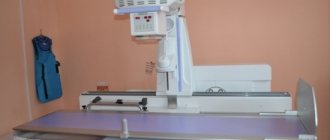How often can an x-ray be taken:
“Modern X-ray machines provide very moderate radiation exposure, and there is no real risk to the child’s health. At the very least, you should understand that if you were forced to take 1-2 x-rays of your child during the year, moreover, if you had to take 6 x-rays in a row in six months, there is still nothing potentially dangerous about this.
I do not at all encourage you to constantly take x-rays, moreover, if every sneeze of your child is a reason for your doctor to send you for an x-ray, then maybe you need to think not about the harmfulness of the x-ray, but about the harmfulness of the doctor, and you need to look for a more experienced specialist.
Popular articles now
In a denim shirtdress: Kate Middleton and Prince William showed new photos with grown-up children
“I wanted and still want..”: Oleg Vinnik spoke about political ambitions
After the wedding with Balan: photos of pregnant Tina Karol stunned the Network
Luxurious blonde Tayune: Oleg Vinnik’s wife appeared on stage with him
show more
However, I would like to draw your attention to the fact that we are surrounded by radiation and a normal plane flight for an hour is approximately the same amount of radiation as one x-ray.” - Komarovsky explained.
Bread and freshly squeezed juice: a famous nutritionist named the most harmful foods in our diet
. Watch the video in which the doctor discusses this topic:
View this post on Instagram
How dangerous is x-ray for a child? These same X-ray examinations? ⠀ Modern X-ray machines provide very moderate radiation, and there is no real risk to the child’s health. At the very least, you should understand that if you were forced to take 1-2 x-rays of your child during the year, moreover, if you had to take 6 x-rays in a row in six months, there is still nothing potentially dangerous about this. ⠀ I do not at all encourage you to constantly take x-rays, moreover, if every sneeze of your child is a reason for your doctor to send you for an x-ray, then maybe you should think not about the harmfulness of x-rays, but about the harmfulness of the doctor, and you need to look for a more experienced specialist. ⠀ Nevertheless, I draw your attention to the fact that we are surrounded by radiation and a normal plane flight for an hour is approximately the same amount of radiation as one x-ray. ⠀ #doctorkomarovsky #videoEOK #shdk #doctorkomarovsky school #safety #x-ray
A post shared by Doctor Komarovskiy (@doctor_komarovskiy) on Feb 4, 2020 at 5:50am PST
Let us remind you that Dr. Komarovsky, a famous pediatrician whose “golden” rules of immunity are used by all parents, has repeatedly sharply expressed his opinion about the behavior of overly caring mothers. Thus, he stated that parents who “run around” with their children and keep the house perfectly clean will have a child get sick faster than those who treat their children more indifferently. This statement caused a storm of emotions and discussions in society, but Evgeny Komarovsky has his own opinion on this matter. Read more by following the link.
No less provocative was the phrase he said that children should not be helped. Why does a pediatrician have such a negative attitude towards parental care? See the answer here.
The doctor also told all caring mothers which porridge, in his opinion, is considered the healthiest: he even compiled a list of seven cereals. But Komarovsky mercilessly criticized semolina, which is so popular with children in kindergarten.
Find more interesting materials and the latest news on the website
Harm from X-rays
Modern diagnostic methods, which are based on the use of X-rays, work with low doses of radiation. They certainly cannot cause harm to the health of the person being examined. But at the same time, X-rays are capable of penetrating deeply into biological systems and disrupting the normal functioning of cells, so they are considered quite dangerous for the human body, especially children.
Although calling every X-ray radiation dangerous is not entirely correct. It becomes like this if it is emitted with a certain force and affects a living organism for a long time.
Deformation of the pulmonary pattern on fluorography
Children react poorly to X-ray radiation and it is dangerous for them for the following reasons:
- A growing body reacts more acutely to radiation exposure, so the risk of abnormalities at the genetic level and the development of various diseases without physical prerequisites increases.
- Irradiation may not make itself felt immediately, but after some time.
- The child’s body may have a non-standard (too close) arrangement of internal organs or they may be unevenly developed.
- Individual characteristics of each growing organism.
Most x-ray-based medical examinations use low-energy x-rays. In addition, they irradiate the child’s body for very short periods of time. Therefore, even if the procedure is repeated many times, they are still considered practically harmless to the child.
Red bone marrow reacts most acutely to X-ray radiation, so blood diseases are most often diagnosed from exposure to X-rays:
- Leukemia or leukemia is a cancer in which bone marrow cells mutate, rather than developing into normal mature white blood cells, but becoming cancer cells.
- Thrombocytopenia is a condition characterized by a decrease in platelet count and increased bleeding.
- Erythrocytopenia is a reduced content of red blood cells per unit volume of blood. In parallel with this, a decrease in hemoglobin is observed. A condition in which red blood cells are low causes oxygen starvation, which negatively affects the developing and growing child’s body.
- Malignant degeneration of cells - under the influence of radiation, cell growth and division are disrupted, which as a result can lead to the formation of oncopathology.
The negative impact of x-rays on a child occurs if he has been exposed to radiation for too long. Modern diagnostic devices with digital recorders make it possible to significantly reduce the dose load of ionizing radiation, so the likelihood of developing dangerous consequences is minimized.
If you undergo X-rays less than 5 times a year, the resulting harm will be minimal.
A few words about doses
When talking about the danger or safety of an X-ray of the spine, it is impossible to ignore such a thing as the radiation dose. The dose measured in mSv tells how much radiation has passed through your body, and the higher the dose, the higher the risk of damage and undesirable consequences.
The radiation dose received during an X-ray examination depends on whether the results are recorded analoguely, on photographic film, or digitally, using a matrix similar to that used in digital cameras or mobile phone cameras. The matrices turn out to be several times more sensitive, which makes it possible to reduce the radiation power by the same amount.
Let's give real numbers.
Note that with CT scans of these parts of the spine, the radiation dose is about 5 mSv.
When X-raying the cervical spine, the radiation power is 0.2 mSv with analog and 0.03 mSv with digital registration. During an X-ray of the thoracic spine, these figures are 0.5 mSv and 0.06 mSv, and in the case of the lumbar spine, 0.7 mSv and 0.08 mSv, respectively.
Features of the procedure in children
Young children over two years old are given x-rays in the presence of adults. Parents ensure the baby's immobility. In cases where the child cannot lie still, he is secured with special straps.
Stillness is an important part of the procedure. The photo will blur at the slightest movement.
The baby is protected as much as possible from unnecessary radiation by wearing a lead apron and pads. Anyone accompanying the child must also wear such an apron.
Children under two years of age are placed in a special flask that ensures immobility.
X-ray flask
Which parts of the body are most exposed to radiation?
As practical radiology shows, in children the lion's share of images is taken from the musculoskeletal system - this area is most often irradiated. In childhood, injuries and injuries are common - dislocations, bruises, fractures. When a child enters the clinic with complaints of a blow or obvious signs of pathology, an x-ray is prescribed.
Congenital pathologies of the musculoskeletal system are also added to the percentage of statistics, when children are diagnosed with dislocations and subluxations in large joints, which requires x-ray diagnostics and further monitoring.
In second place in popularity are the chest organs, since if the Mantoux reaction is positive, an x-ray is taken. A positive Mantoux can be either a demonstration of pathology or a banal irritation and scratching of the sample area, but in any case, diagnosis is required.
What is radiography of the paranasal sinuses?
X-ray of the paranasal sinuses (paranasal sinuses) is a diagnostic method that is based on the projection of X-rays onto paper or film.
X-ray radiation passes through organs and structures and is partially attenuated in the process. As a result of passing through tissues of different densities, an image with different intensities is formed on the screen.
Modern devices do not require film to operate, and the image is captured on a special electronic matrix and can be viewed on the monitor screen.
Advantages and disadvantages of the method
The key advantages are:
- speed of obtaining information;
- availability;
- relatively low price;
- no special preparation of the patient is required;
- the image is recorded and can be used for consultation with another specialist;
- no discomfort or pain during the examination.
Based on the obtained x-ray data, the specialist can make a diagnosis, confirm or exclude the presence of pathology in the sinuses and carry out a differential diagnosis of nasal diseases.
Despite the obvious advantages, the method has a number of disadvantages:
- A flat, static image that does not allow one to evaluate dynamic structures.
- Certain harm from ionizing radiation to the patient.
- The information content of an X-ray of the nose is lower than the study of a similar area using CT or MRI.
- Inability to assess soft tissue.
- An X-ray of the nasal bones during a fracture does not make it possible to assess the location of the fragments.
- Not all sinuses are clearly visible using x-rays.
Thus, in some cases, a diagnosis can be made based on this method. In other situations, the specialist will need additional research to determine treatment tactics.
Important! The following paranasal sinuses are distinguished in the human body: maxillary, frontal, ethmoid and sphenoidal. The X-ray image clearly visualizes the frontal and maxillary, as well as partially ethmoid.











